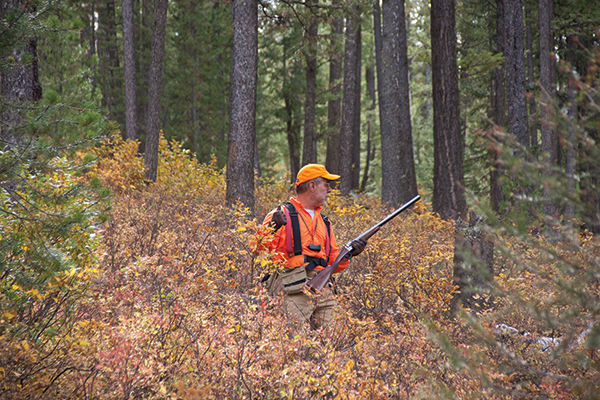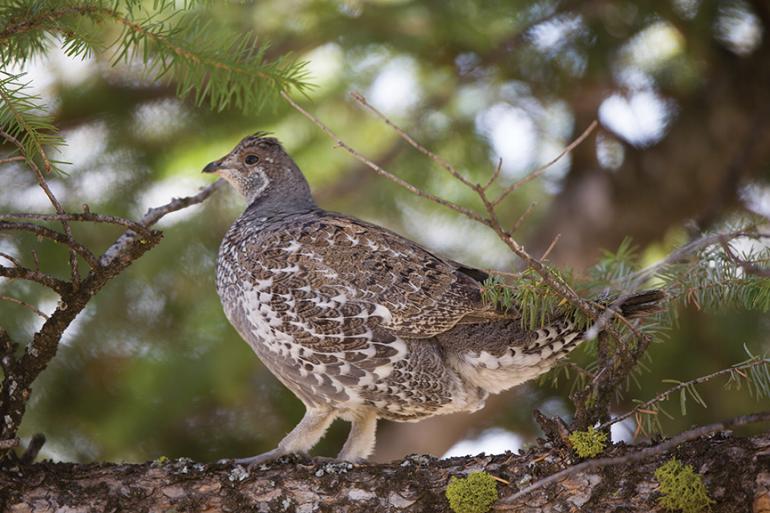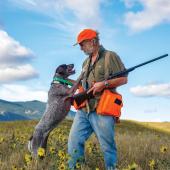High-Country Blues
The illustrious mountain grouse.
For the elk hunter, the lust for autumn is singular, an inner nagging, a fretting about shooting the bow enough, or practicing calling enough. But for the upland hunter, that yearning for the best, shortest month comes from the whole darned pack of bird dogs you’ve fed all summer long. They squirm at your feet and slobber all over everything, chew on things they shouldn’t. August is a tough month for the pent-up frustrations of canine and master. Training and repetition is all well and good, but there is no substitute for the real thing, for bird-hunting season. It can’t get here soon enough.
Then September dawns and we are out in it, as effervescent as a shaken beer bottle. This is the month of the high country—high-country blues.
There are several things I love about hunting high-country blue grouse and they are all tied for first place. First, there’s the country itself, the mountain holds that frost up in the dawn and bake to t-shirt weather by mid-morning. There’s the dogs, living their wonderful optimistic lives and bursting out into the climbing day. There’s the bird, a contradiction of traits: jumpy yet naïve, challenging yet easy. There’s the exercise, the climbing, the sweating, the hard work for the good reward. And finally there is the liberty of public land, all free for the walking, not a door knocked on, not a permission asked. No need to go hat-in-hand begging to hike a cornfield. No, this is ours. Yours. Mine. Just go.
Habitat
Blue grouse are found all over southwest Montana, but their habitat is very specific depending upon the time of the season you go after them. It is critical that you remember that they live their lives in reverse. When other animals drop from the high country to the foothills as fall and then winter descends, blue grouse go the other way. Up. Always up. Early in the season, the broods of hens and their chicks can be found in the foothill coulees of aspen and chokecherry. Mark your calendar log book and go back to the same place at the same time next year and you’ll probably find them there again. But wait a few weeks and they won’t be there. They’ll be above you.
An even surer pattern for the hunter than young birds in coulees are ridgelines. Go to the ridge top. Look for timber with openings for flight. Blue grouse love ridge tops, particularly those that have good stands of young and older Douglas fir on at least one side. Pushing up one ridge to the top of a drainage, and down a parallel ridge is a good way to hunt blue grouse up and down. And remember the elevation. Mark it down. Plus the date. Pretty soon, you’ll have a whole list of possible blue-grouse covers in your memory.
If you find yourself in good habitat without any birds, you have two choices. The birds will either be above you, or they’ll be below you. As you gain experience, you’ll tend to know the right way to go. Lower earlier, higher later.

Behavior
Habitat and food go hand-in-hand. Early-season birds will be stuffed full of berries from chokecherries to snowberries to currants. They also love grasshoppers and other insects. Later in the year, as the birds move up into the mountains, they’ll pick at the dwindling berries, or stuff themselves on an assortment of leaves. Finally, as the season tails off, they key on spruce and fir needles, a diet that will carry them through the roughest winters.
The elk hunter has a fairly low opinion of blue grouse because they can act pretty darned dumb when they aren’t being hunted with dogs. They walk away slowly, or fly ten feet up in a tree. But put a dog on the ground and you’ll get a whole different bird. They can fly fast and far, often pitching down off ridges in a falling-away soaring flight that is really difficult for the shotgunner. They can hold for a point, or flush wild. Often there’s a tree in the way of a shot pattern.
Gear
A blue-grouse adventure takes you into some of the prettiest country in Montana. I like to be prepared to go for at least a half a day in order to bag a limit of three birds, or get gassed out trying. I’ll carry a small pack with my license, a water source for me and a water source for the dog (even though there may be springs or seeps up on the mountain), snacks and basic mountain gear like a GPS, a map, and a first-aid kit. An extra layer always helps too, particularly later in the season when you’ll be shedding layers climbing and donning them descending. A camera is also a nice touch, as are a small set of compact binoculars to scout routes and potential blue-grouse holds. I carry a 20-gauge autoloader with six shot for the entire season. Some people prefer 12- or 16-gauge guns, and they work great too. Size six shot is the key.
Regs
The season lasts all fall and well into winter, from September 1 all the way to January 1. Later in the year, the hunting gets tougher because the birds are more wary, certainly, but also because the mountains are harder to reach. Snowshoes can be a nice touch for a human, but getting your dog into the hunting area can be a challenge when the snow gets deeper. By the time the end of the season rolls around, most hunters are back home in front of the woodstove dreaming about next year and feasting on the delicious white meat of a grouse in the pot.
Tom Reed writes from his house outside Pony where he and his family maintain a pack of bird dogs between hunting seasons. A new version of his book, Give Me Mountains For My Horses, can be found in local bookstores.
Two in the Bush
Mountain grouse may be the main quarry in southwest Montana, but don’t overlook the lowland opportunities. Though rare around southwest Montana, sharp-tailed grouse are worth keeping an eye out for. They’re a prairie bird; you’ll find them in open, grassy expanses, often on benches and plateaus above area rivers. They tend to mingle in small groups and cluck a lot, especially as they break into flight. Sharpies look a lot like hen pheasants, so use caution when in or near pheasant habitat.
Given the short season, low bag limit (only two per day), and scarcity of habitat, sage grouse are the least-hunted bird in Region 3. But they’re also the biggest, fattest, and, arguably, the most fun to hunt. Roaming wide-open sage flats, mountains all around, dog darting through the brush in search of fresh scent… this is Montana bird hunting at its finest. Scout during the summer and if possible, negotiate future access with ranchers.—Mike England










